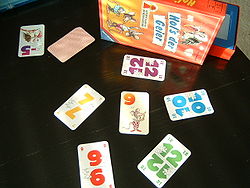The vulture will get it
| The vulture will get it | |
|---|---|
 The player with the blue 10 wins the nine-mouse |
|
| Game data | |
| author | Alex Randolph |
| graphic |
Wilfried Gebhard (Ravensburger), Frantz Rey (Asmodée) |
| publishing company |
Ravensburger (1988), FX Schmid (1998), FX / Ravensburger (1999), Winning Moves (1995), Asmodée Editions , Amigo (2018) |
| Publishing year | 1988, 1995, 1998, 1999, 2018 |
| Art | Card game |
| Teammates | 2 to 5 |
| Duration | 10-20 minutes |
| Age | from 10 years on
|
| Awards | |
|
Game of the Year : Shortlist 1988 |
|
Get the Vultures is a card game by game designer Alex Randolph .
It is said to be based on a traditional Indian card game, which Randolph published with an Indian theme in the USA as Raj .
expenditure
In Germany, the game was published in 1988 as Hol's der Geier by Ravensburger (subject: Mice and Vultures) and was included in the selection list for Game of the Year 1988. The German name of the game is reminiscent of the same phrase get's the vulture or pick you the vulture , with a negative curse is to be expressed and also to the gluttony of Geier recalls. Ravensburger published the game in other languages as well: In France it appeared under the name Stupide Vautour ( Silly Vulture). In Eastern Europe (Poland, Czech Republic, Slovakia, Hungary) the game is called Mini Hazard and Ravensburger brought out an English edition as Beat the Buzzard . In Italy, Ravensburger brought the game with the theme of sheep and wolves as In Bocca al Lupo! out.
In Germany, Hol's der Geier was also released by FX Schmid in 1998 and, after Ravensburger took over FX Schmid in 1999, on the Ravensburger label FX . Asmodée Editions brought out a version of Stupide Vautour with modified graphics, licensed by Week-End Games for France . In 1995 the game appeared as Raj at Randolph's newly founded publisher Winning Moves with an Indian theme. In 2018, Amigo released a new edition of the game , in which the old "Mice and Vultures" theme was changed to a "Meerkat and Vulture" theme.
regulate
The game is aimed at two to five players from about 10 years of age and brings the greatest number of participants to play. A game lasts around 15-20 minutes. It has a large tactical component, and in order to win it requires a certain memory of who has already played which card.
content
The game consists of 5 sets of number cards from 1 to 15. They have a mouse on the back. There are 15 animal cards left, with a vulture on the back. The animal cards are divided into 10 mouse cards with the values +1 to +10 and 5 vulture cards from −1 to −5.
procedure
Each player receives a set of cards of the same color with the values 1 to 15. The animal cards are shuffled and placed face down. Then the first scoring card is revealed and played for it. If it is a card with a mouse motif, the other players try to get it into their possession, but avoid calling the negative vulture card your own. Each player now draws a card from his set and together these are revealed. Whoever showed the highest card wins the mouse card. However, if it was a question of a vulture card, the player who placed the lowest card receives it. Then the number cards are deposited.
If two or more players are tied after being shown, the second-highest (or second-lowest) card receives the loot . If all players even show the same value, all cards are discarded, an additional scoring card is revealed and the next round of bidding involves both scoring cards . The winner of the game is whoever was able to achieve the most plus points at the end, the amounts of the negative points are subtracted.
Special rule
With two players there is a special rule that each player draws three cards from his set and discards them. Also from the scoring cards are three stored away and concealed, so that it only twelve Ausspielrunden are.
Web links
- Get the vulture in the Luding games database
- The vulture gets it from Michas-Spielmitmir
- Get the vulture from Bruno Faidutti (French / English)
- Raj in the game database BoardGameGeek (English)
- Get the vulture (new edition 2018) on Brettspiele-Magazin.de
Individual evidence
- ↑ Get the vulture at fairspielt.de
- ↑ a b Bottom of the box from Stupide Vautour (Asmodée) in the board game database BoardGameGeek (English)
- ↑ a b Get the vulture from Bruno Faidutti (French / English)
- ↑ The bottom of the box from Raj in the board game database BoardGameGeek (English)
- ↑ box base of mini Hazard in the games database BoardGameGeek (English)
- ↑ Image from In Bocca al Lupo! in the games database BoardGameGeek (English)